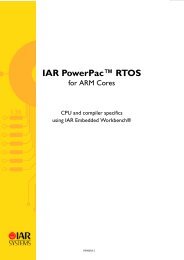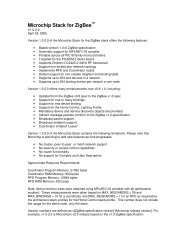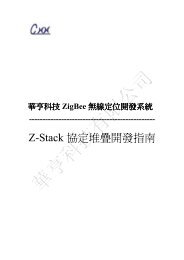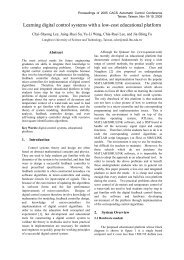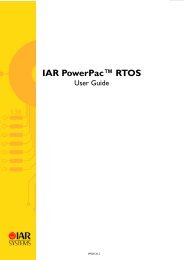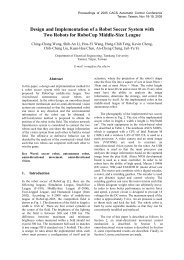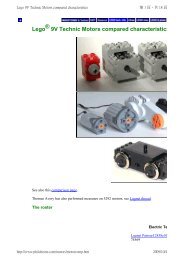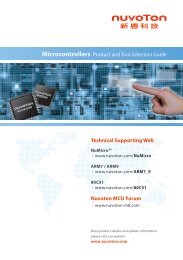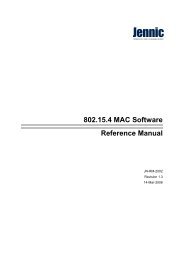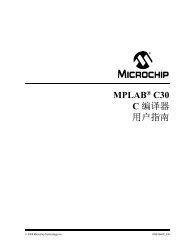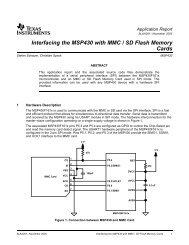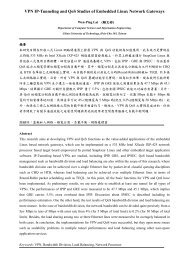Combination of Membership-Functions-Modified Fuzzy Controller ...
Combination of Membership-Functions-Modified Fuzzy Controller ...
Combination of Membership-Functions-Modified Fuzzy Controller ...
You also want an ePaper? Increase the reach of your titles
YUMPU automatically turns print PDFs into web optimized ePapers that Google loves.
Proceedings <strong>of</strong> 2005 CACS Automatic Control ConferenceTainan, Taiwan, Nov 18-19, 2005<strong>Combination</strong> <strong>of</strong> <strong>Membership</strong>-<strong>Functions</strong>-<strong>Modified</strong> <strong>Fuzzy</strong><strong>Controller</strong> with PID <strong>Controller</strong> for Performance ImprovementYun-Tien Chang 1 and Yau-Tarng JuangDepartment <strong>of</strong> Electrical EngineeringNational Central UniversityNo. 300, Jhongda Rd., Jhongli City, Taoyuan County, Taiwan1. Email: yun_ten@ms58.url.com.tw摘 要在 本 文 中 , 藉 著 修 改 模 糊 邏 輯 控 制 器 之 三 角 形的 歸 屬 函 數 與 結 合 比 例 、 積 分 與 微 分 控 制 器 來 改 善系 統 響 應 的 性 能 , 上 升 時 間 , 最 大 超 越 量 , 和 積 分 誤 差等 . 模 糊 邏 輯 控 制 器 的 所 有 參 數 在 本 文 中 皆 是 由 基 因演 算 法 所 求 得 。 最 後 , 本 文 會 藉 由 電 腦 程 式 的 模 擬來 實 現 此 模 糊 邏 輯 控 制 器 , 並 利 用 修 改 歸 屬 函 數 來得 到 更 佳 的 系 統 響 應 與 效 能 。關 鍵 詞 : 歸 屬 函 數 , 模 糊 邏 輯 控 制 器 ,PID 控 制 器 ,基 因 演 算 法 。AbstractIn this paper, the triangular membership functionsused in a fuzzy logic controller are modified toimprove the rise time, overshoot, and integral <strong>of</strong> theabsolute error (IAE). All the parameters <strong>of</strong> the fuzzylogic controller and proportional-integral-derivative(PID) controller are determined by means <strong>of</strong> geneticalgorithms (GA). Simulation results show a betterperformance is obtained when modified membershipfunctions are utilized.Keywords:membership functions, fuzzy logiccontroller, PID controller, geneticalgorithms(GA’s).optimizations, self-adaptive control, and learningsystems [12]. Via genetic algorithms a betterperformance is obtained [13-14].In this paper, we will propose a simple method tomodify the traditional triangular membership functions.This modification results in a better performance,defined by considering the rise time, the overshoot, andthe IAE. The paper is organized as follows. In Section2, main results are presented. In Section 3, geneticalgorithms are introduced. In Section 4, a performanceindex based on genetic algorithms is given. Simulationresults are shown in Section 5. Conclusions arepresented in Section 6.2. Main resultsA system with the combination <strong>of</strong> a fuzzy logiccontroller (FLC) and PID controller is shown in Figure1. The FLC is a double-input and single-output (DISO)controller. Usually, the tracking error e and thedifferential tracking error, e& are input to the fuzzyinference system. In beginning, the triangularmembership functions are used.1. IntroductionThe PID controllers are used in industrial processcontrol [1]. The PID controllers have simple structuresand are easy to be understood by a great majority <strong>of</strong>industrial practitioners and automatic control designers.Many tuning methods have been proposed in theliterature [2]. Such as the Ziegler-Nichols method[3-4].Recently, many researchers attempt to combinePID controllers with fuzzy control [5]. To add expertexperiences, the use <strong>of</strong> fuzzy logic seems to beparticularly appropriate [6]. Several solutions areproposed on this basis [7-10]. Except combining PIDcontrollers with fuzzy control, a fuzzy controller, withappropriate weightings is proposed to improve systemperformance [11].Genetic algorithms (GA) are searching proceduresand can be applied to a variety <strong>of</strong> functionFigure 1. A fuzzy system with PID controller.To improve the system performance, e.g., risetime and IAE, etc., the modification <strong>of</strong> the triangularmembership functions are proposed as follows. Definea clipping function f ( x ) asc⎧ 1 1 ≤ x⎪fc( x) = x 0 < x < 1(1)⎨⎪⎩ 0 x ≤ 0Now the following expert knowledge will be used tomodify the original membership functions to improvethe performance, the original membership functions areshown in Figure 2 (dotted line) for e and Figure 3 fore& . Let NB mean negative big, Zo mean zero, and PBmean positive big.
Consider the case when the error e is near 0, i.e.,0 < e < E 1, where E1is a given positive number. Toimprove the performance, the membership function forlinguistic variable 〝Zero〞 is emphasized by adding apositive constant temp1 to it, i.e.,m ( e) = f [ m ( e) + temp1].(2)n, zo c o,zowhere m,( ⋅ ) denotes the original membershipo z<strong>of</strong>unction for 〝 Zero 〞 and m,( ⋅ ) the newn zomembership function. To keep the sum <strong>of</strong> membershipfunction <strong>of</strong> e being 1, the membership function forlinguistic variable 〝Positive〞 will be decrease by thesame constant temp1, i.e.,m ( e) = f [ m ( e) - temp1].(3)n, pb c o,pbNext, consider the case when the error e ispositive and big, i.e., e > E2, where E2is a givenpositive number. The decision table and linguisticvariables are shown in Tab. 1.In order to improve the performance, themembership function <strong>of</strong> the linguistic variable〝Positive〞is emphasized by adding a positive constanttemp2, i.e.m ( e) = f [ m ( e) + temp2].(4)n, pb c o,pbThe membership function for variable 〝Zero〞 shouldbe decreased by the same amount, i.e.,m ( e) = f [ m ( e) -temp2].(5)n, zo c o,zoAs for E1 < e < E2, the membership function isnot change.For negative error e, similar adjustment on themembership functions is made. In the following, theadjustment on the original membership functions issummarized as⎧ fc[ mo , pb( e) + temp2]⎫⎪⎬ if E2≤ e⎪fc[ mo,zo( e) - temp2]⎭⎪mo,zo( e)⎪⎫⎪if E1 < e < E2⎪⎬mo,pb( e)⎪⎪⎭⎪ fc[ mo,zo( e) + temp1]⎫⎪⎬ if 0 ≤ e ≤ E1⎪ fc[ mo,pb( e) -temp1]⎭mn( e)= ⎨⎪ fc[ mo,zo( e) + temp3]⎫⎪⎬ if E3≤ e ≤ 0fc[ mo,nb( e) - temp3]⎪⎭⎪ mo,zo( e)⎫⎪⎪ ⎬ if E4 < e < E3⎪ mo,nb( e)⎪⎭⎪⎪ fc[ mo , nb( e) + temp4]⎫⎪⎬ if e ≤ E4⎩fc[ mo , zo( e) - temp4]⎭(6)The new membership functions are shown in Figure 2.E −E 4E 3E 1E2E +Figure 2. <strong>Membership</strong> functions for e.E&−Figure 3. <strong>Membership</strong> functions for ė .The decision table is given in Table 1.E &+Table 1. The decision table.e&eNB ZO PBNB NB NB ZOZO NB ZO PBPB ZO PB PB3. Genetic AlgorithmsRecently, many GA’s have been presented [14].The basic construction <strong>of</strong> a GA can be simplydescribed as follows.1) Define the String <strong>of</strong> a Chromosome:These parameters are genes in a chromosome,which can be binary coded or real coded and termed“chromosome.”2) Define the Fitness Function:The fitness function is the performance index <strong>of</strong> aGA to resolve the viability <strong>of</strong> each chromosome.3) Generate an Initial Population:N sets <strong>of</strong> chromosomes should be randomlygenerated before using a GA operation. Thesechromosomes are called the initial population.4) Generate the Next Generation or Stop:GA’s use the operations <strong>of</strong> reproduction,crossover, and mutation to generate the next generation.From generation to generation, the maximum value <strong>of</strong>the fitness value is achieved for each generation.
3.1 Elite MethodWe select the best individual <strong>of</strong> each generationwithout the three basic operations, and make it be amember <strong>of</strong> the new generation.3.2 Reinforced Search MethodThe worst individual should be mutated withhigher mutation rate. We will select the N inferiorstrings to mutate but the size <strong>of</strong> N should be smallenough.5. Simulation resultsExample 1Consider a plant G(s) from [15]:10s+ 1G( s)=(8)3 2s + 11s + 30sIn the following, three design methods are usedand simulated for comparison. The unit response wassimulated by Matlab and Simulink.Method 1: Only PID controller is used. Theproportional gain K p , integral time T i , and derivativetime T d are determined by the genetic algorithm. Weget K p =9.79, K i =10, K d =0.18 by the genetic algorithm.The step response is showed in Figure 5. Note that theresponse is too slow with the rise time 0.22 sec and themaximum overshoot 1.79% is large.Figure 5. The step response based on a geneticalgorithm tuned PID controller.(K p =9.79, K i =10, K d =0.18)Figure 4. The complete flow chart <strong>of</strong> the geneticalgorithms.4. Performance indexThe performance index is defined as− rt 2 os 2( ) ( )w−1 w2IAE 2( )w3Performance index e e e −=(7)where rt, os, and IAE are the rise time, the maximumovershoot and the integral <strong>of</strong> the absolute error. The w 1 ,w 2 and w 3 are given weightings on the rise time, themaximum overshoot and the integral <strong>of</strong> the absoluteerror, respectively. Then a GA is used to search for anoptimal PID values, E1, E2, E3, E4, temp1,temp2, temp3, and temp4.Method 2: The controller <strong>of</strong> system adopts theweighted fuzzy-PID controller [11]. All parametersincluding K p , K i and K d are tuned by a GA. The stepresponse is showed in Figure 6. It is noticed that theoscillation attenuation is assured and the performanceis better than before. The result is showed in Table 2.The rise time, settling time, maximum overshoot andIAE are improved.Method 3: The controller <strong>of</strong> the system adopts thecombination <strong>of</strong> the modified membership functions anda PID controller. All parameters including K p , K i andK d are tuned by a GA. The step response is showed inFigure 7. As shown in Table 2, the rise time, settlingtime, maximum overshoot and IAE are furtherimproved as compared to those using the weightedfuzzy-PID controller’s method for this plant.
Figure 6. The step response using the weightedfuzzy-PID controller.Figure 8. The step response using a PID controller.(K p =10, K i =0, K d =4.10)Figure 7. The step response using the fuzzy-PIDcontrollers with modified membershipfunctions.Figure 9. The step response using the weightedfuzzy-PID controller.Table 2. Simulation results for methods 1~3.RisePerformance time(Sec)Settlingtime(Sec)Maxovershoot(%)Integral <strong>of</strong> theabsolute errorMethod 1 0.22 1.15 1.79 34.93Method 2 0.18 0.25 0.56 17.26Method 3 0.12 0.14 0.28 8.69The simulation results demonstrate the merits <strong>of</strong>the proposed method 3.Example 2Consider a plant G(s) from [15]:2s + 2s+ 2G( s)=(9)4 3 2s + 5s + 6sAs in example 1, the results based on methods1~3 are showed in Figure 8 and Figure 9 and Figure 10.The modified membership functions for the systemerror e are showed in Fig. 11.Figure 10. The step response using the fuzzy-PIDcontrollers with modified membershipfunctions.Figure 11. <strong>Membership</strong> functions for e.
Table 3. Simulation results for methods 1~3.Rise Settling MaxIntegral <strong>of</strong> thePerformance time time overshootabsolute error(Sec) (Sec) (%)Method 1 0.92 3.38 13.01 84.88Method 2 0.19 0.32 3.40 22.40Method 3 0.08 0.08 2.64 9.01The simulation results demonstrate the merits <strong>of</strong>the proposed method 3.6. ConclusionsIn this paper, traditional triangular membershipfunctions in a FLC are modified to improve theperformance, such as the rise time, the overshoot, andthe IAE. The two illustrative examples show thatimproved performance are achieved by the proposedmethod.7. ReferencesConference, Chung-Li, Taiwan, 2004.[12] J. H. Holland, Adaptation in Natural and ArtificalSystems, Ann Arbor, MI: University <strong>of</strong>Michigan, 1975.[13] HOMAIFAR, A., and McCORMICK, E.:”Simulta- neous design <strong>of</strong> membership functionsand rule sets for fuzzy controllers using geneticalgorithms,” IEEE Trans. <strong>Fuzzy</strong> Sys., Vol. 3, No.2 pp.129-139, 1995.[14] J. J. Zhao, Design <strong>of</strong> Optimal <strong>Fuzzy</strong> <strong>Controller</strong>sBased on Genetic Algorithms. Master Thesis,NCU, 1996.[15] Benjamin C. Kuo, “Automatic Control System,”Seven Edition, 1995.AcknowledgementsThis work was partially supported by the NationalScience Council under the contract NSC 93-2213-E008-021.[1] G. Chen, “Conventional and fuzzy PID controllers:an overview,” Intelligent Control & System,vol.1,pp.235-246, 1996.[2] K. Astrom and T. Hagglund, PID <strong>Controller</strong>s:Theory, Design and Tuning. New York: ISA, 1995.[3] ASTRÖM, K., and HÄGGLUND, T.: “PIDcontrollers: Theory, design and tuning” (ISA Press,1995)[4] J. G. Ziegler and N. B. Nichols, “Optimum settingfor automatic controllers,” ASME Trans. pp.759-748, 1942.[5] Zhihong Xiu, Guang Ren, “Interpolation model andoptimization design <strong>of</strong> TS-PID controller” in Proc.Of International Conference on <strong>Fuzzy</strong> InformationProcessing Theories and Applications, Beijing,March 2003, pp.301-306[6] S. G. Tzafestas, “<strong>Fuzzy</strong> systems and fuzzy expertcontrol: an overview,” Knowl. Eng. Rev, Vol. 9, No.3 pp.229-268, 1994.[7] S. G. Tzafestas, and PAPANIKOLOPOULOS, N.P.“Incremental fuzzy expert PID control,” IEEETrans. Ind. Electron., Vol.37, No.5 pp.365-371,1990.[8] HE, S. Z., TAN, S., and XU, F.-L.:”<strong>Fuzzy</strong> selftuning<strong>of</strong> PID controllers,” <strong>Fuzzy</strong> Sets Sys.,pp.37-46, 1993.[9] ZHAO,Z.-Y., TOMIZUKA,M., and ISAKA,S.”<strong>Fuzzy</strong> gain scheduling <strong>of</strong> PID controllers,” IEEETrans. Sys. Man, Cybern., Vol. 23, No. 5pp.1392-1398, 1993[10] VISOLI, A. ”<strong>Fuzzy</strong> logic based set-pointWeighting for PID controllers,” IEEE Trans. Sys.Man, Cybern. PT. A,, Vol. 29, NO. 6 pp.587-592,1999.[11] Chien-Shiung Chao, Tai-Zu Wu and Yau-TarngJuang, ”Weighted <strong>Fuzzy</strong>-PID controllers,”Proceeding <strong>of</strong> 2004 Automatic Control




